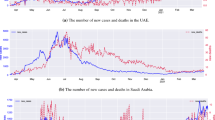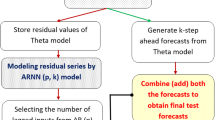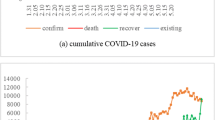Abstract
This paper analyzes single and two-wave COVID-19 outbreaks using two novel hybrid models, which combine machine learning and statistical methods with Richards growth models, to simulate and forecast the spread of the infection. For this purpose, historical cumulative numbers of confirmed cases for three countries, including Iran, Italy, and Mexico, are used. The analysis of the Richards models shows that its single-stage form can model the cumulative number of infections in countries with a single wave of outbreak (Italy and Mexico) accurately while its performance deteriorates for countries with two-wave outbreaks (Iran), which clarifies the requirement of multi-stage Richards models. The results of multi-stage Richards models reveal that the prevention of the second wave could reduce the outbreak size in Iran by approximately 400,000 cases, and the pandemic could be controlled almost 7 months earlier. Although the cumulative size of outbreak is estimated accurately using multi-stage Richards models, the results show that these models cannot forecast the daily number of cases, which are important for health systems’ planning. Therefore, two novel hybrid models, including autoregressive integrated moving average (ARIMA)-Richards and nonlinear autoregressive neural network (NAR)-Richards, are proposed. The accuracy of these models in forecasting the number of daily cases for 14 days ahead is calculated using the test data set shows that forecast error ranges from 8 to 25%. A comparison between these hybrid models also shows that the machine learning-based models have superior performance compared with statistical-based ones and on average are 20% more accurate.
Access this chapter
Tax calculation will be finalised at checkout
Purchases are for personal use only
Similar content being viewed by others
References
Xie M, Chen Q (2020) Insight into 2019 novel coronavirus—an updated interim review and lessons from SARS-CoV and MERS-CoV. Int J Infect Dis 94:119–124
McBryde ES, Meehan MT, Adegboye OA, Adekunle AI, Caldwell JM, Pak A et al (2020) Role of modelling in COVID-19 policy development. Paediatr Respir Rev
George DB, Taylor W, Shaman J, Rivers C, Paul B, O’Toole T et al (2019) Technology to advance infectious disease forecasting for outbreak management. Nat Commun 10(1):1–4
Chretien J-P, Riley S, George DB (2015) Mathematical modeling of the West Africa Ebola epidemic. Elife 4:e09186
Ren H, Zhao L, Zhang A, Song L, Liao Y, Lu W et al (2020) Early forecasting of the potential risk zones of COVID-19 in China’s megacities. Sci Total Environ 729:138995
Cássaro FAM, Pires LF (2020) Can we predict the occurrence of COVID-19 cases? Considerations using a simple model of growth. Sci Total Environ 728:138834
Roosa K, Lee Y, Luo R, Kirpich A, Rothenberg R, Hyman JM et al (2020) Real-time forecasts of the COVID-19 epidemic in China from February 5th to February 24th, 2020. Infect Dis Model 5:256–263
Chowell G (2017) Fitting dynamic models to epidemic outbreaks with quantified uncertainty: a primer for parameter uncertainty, identifiability, and forecasts. Infect Dis Model 2(3):379–398
Calafiore GC, Novara C, Possieri C (2020) A time-varying SIRD model for the COVID-19 contagion in Italy. Annu Rev Control
Hsieh Y-H (2009) Richards model: a simple procedure for real-time prediction of outbreak severity. In: Modeling and dynamics of infectious diseases. World Scientific, pp 216–36
Hsieh Y (2010) Pandemic influenza A (H1N1) during winter influenza season in the southern hemisphere. Influenza Other Respir Viruses 4(4):187–197
Hsieh Y, Chen CWS (2009) Turning points, reproduction number, and impact of climatological events for multi-wave dengue outbreaks. Trop Med Int Health 14(6):628–638
Wang X-S, Wu J, Yang Y (2012) Richards model revisited: validation by and application to infection dynamics. J Theor Biol 313:12–19
Li Q, Guo N-N, Han Z-Y, Zhang Y-B, Qi S-X, Xu Y-G et al (2012) Application of an autoregressive integrated moving average model for predicting the incidence of hemorrhagic fever with renal syndrome. Am J Trop Med Hyg 87(2):364–370
Benvenuto D, Giovanetti M, Vassallo L, Angeletti S, Ciccozzi M (2020) Application of the ARIMA model on the COVID-2019 epidemic dataset. Data Brief 29:105340
Davenport T, Kalakota R (2019) The potential for artificial intelligence in healthcare. Future Healthc J 6(2):94
Chimmula VKR, Zhang L (2020) Time series forecasting of COVID-19 transmission in Canada using LSTM networks. Chaos Solitons Fractals 135:109864
Ribeiro MHDM, da Silva RG, Mariani VC, dos Santos Coelho L (2020) Short-term forecasting COVID-19 cumulative confirmed cases: perspectives for Brazil. Chaos Solitons Fractals 135:109853
Currie CSM, Fowler JW, Kotiadis K, Monks T, Onggo BS, Robertson DA et al (2020) How simulation modelling can help reduce the impact of COVID-19. J Simul 14(2):83–97
Hasan N (2020) A methodological approach for predicting COVID-19 epidemic using EEMD-ANN hybrid model. Internet Things 11:100228
WHO coronavirus Diesease (COVID-19) Dashboard [Internet] (2020). Available from: https://covid19.who.int/table
Naemi A, Mansourvar M, Schmidt T, Wiil UK (2020) Prediction of patients severity at emergency department using NARX and Ensemble learning. In: 2020 IEEE international conference on bioinformatics and biomedicine (BIBM). IEEE, pp 2793–9
Author information
Authors and Affiliations
Corresponding author
Editor information
Editors and Affiliations
Rights and permissions
Copyright information
© 2022 The Author(s), under exclusive license to Springer Nature Singapore Pte Ltd.
About this chapter
Cite this chapter
Naemi, A. et al. (2022). Forecasting the COVID-19 Spread in Iran, Italy, and Mexico Using Novel Nonlinear Autoregressive Neural Network and ARIMA-Based Hybrid Models. In: Howlett, R.J., Jain, L.C., Littlewood, J.R., Balas, M.M. (eds) Smart and Sustainable Technology for Resilient Cities and Communities. Advances in Sustainability Science and Technology. Springer, Singapore. https://doi.org/10.1007/978-981-16-9101-0_9
Download citation
DOI: https://doi.org/10.1007/978-981-16-9101-0_9
Published:
Publisher Name: Springer, Singapore
Print ISBN: 978-981-16-9100-3
Online ISBN: 978-981-16-9101-0
eBook Packages: Intelligent Technologies and RoboticsIntelligent Technologies and Robotics (R0)




